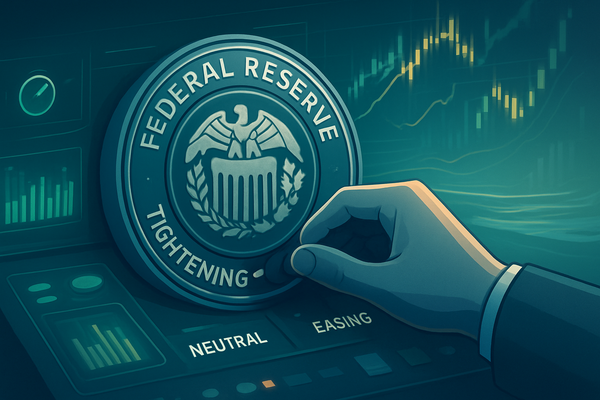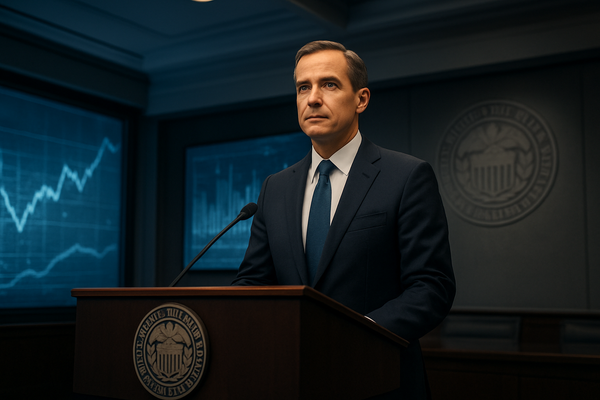Market Breathes Sigh of Relief: A Comprehensive Outlook Post-Government Shutdown Resolution

The financial markets are experiencing a significant resurgence of optimism as the United States government concludes its prolonged shutdown, which, at 40 days, marked the longest in the nation's history. This anticipated resolution, reached on November 10, 2025, through a Senate deal, has injected a palpable sense of relief across global financial markets, signaling a return to normalcy and a dissipation of the political uncertainty that had clouded the economic landscape. While the immediate aftermath is characterized by a "relief rally" and renewed investor confidence, the underlying challenges and long-term implications of such recurring fiscal impasses warrant careful consideration. The resolution, while welcome, serves as a stark reminder of the intricate connections between political stability and economic health, prompting a re-evaluation of market resilience and strategic planning for businesses and investors alike.
The Long Road to Reopening: Detailing the Shutdown and Its Resolution
The recent government shutdown, which commenced due to an impasse over federal spending, saw a significant portion of federal operations grind to a halt. The Antideficiency Act of 1982 mandates that federal agencies cease non-essential functions if no appropriations are in place, leading to the furlough of hundreds of thousands of federal employees and the suspension of numerous government services. While essential personnel, such as air traffic controllers and TSA agents, continued to work without pay, the disruption was widespread, affecting everything from national parks and museums to critical economic data releases.
The timeline leading up to this resolution was fraught with intense negotiations between Congress and the President. Disagreements over budget allocations and policy riders attached to appropriation bills prevented the passage of 12 individual appropriations bills for the fiscal year starting October 1. A continuing resolution (CR) was initially proposed but failed to garner sufficient support, ultimately triggering the shutdown. Key players, including the President, House and Senate leadership, and various federal agencies, were deeply embroiled in the crisis. The Office of Management and Budget (OMB) provided guidance to agencies on implementing shutdown contingency plans, while federal employees braced for missed paychecks. The resolution, a Senate-led deal, aims to fund some departments through January 30, 2026, and others with full-year appropriations, providing a temporary reprieve but also highlighting the potential for future fiscal cliffs. This prolonged closure, surpassing the 35-day shutdown of 2018-2019, underscored the escalating nature of partisan gridlock and its direct economic consequences. Initial market reactions during the shutdown were characterized by increased volatility and a "risk-off" sentiment, with delays in crucial economic data like jobs reports and inflation figures leaving investors "flying blind." However, the news of the resolution immediately triggered a strong, broad-based rally across major stock indices, including the S&P 500, Nasdaq, and Dow Jones Industrial Average, as political risk premiums began to unwind.
Navigating the Aftermath: Winners, Losers, and Strategic Shifts
The resolution of the government shutdown ushers in a period of recalibration, with various sectors and public companies experiencing differing impacts. While the overall market sentiment is positive, the effects are not uniform, and some economic losses are permanent.
Sectors and Companies That Will Benefit:
The immediate beneficiaries of the resolution are typically those that were most directly impacted by the shutdown's disruptions. Government contractors, particularly larger defense and IT service providers, are expected to see accelerated order fulfillment and fund disbursements as delayed contracts and payments are processed. Companies like Lockheed Martin (NYSE: LMT), Northrop Grumman (NYSE: NOC), and Raytheon Technologies (NYSE: RTX) are poised for a rebound as project approvals and funding resume. The consumer discretionary sector is also set for a boost, as furloughed federal employees receive back pay and consumer confidence improves. This will likely translate into increased spending at retailers like Walmart (NYSE: WMT) and Target (NYSE: TGT), and restaurant chains such as Starbucks (NASDAQ: SBUX). The travel and transportation industry, which suffered from reduced government and business travel, is also expected to see a positive bounce. Airlines like Delta Air Lines (NYSE: DAL) and American Airlines (NASDAQ: AAL) could see increased bookings as operational disruptions subside and travel normalizes. Furthermore, sectors sensitive to economic growth, such as financials and industrials, typically see capital inflows as "risk-on" sentiment returns.
Sectors and Companies Facing Lingering Challenges:
Despite the overall positive market reaction, some sectors and businesses will face protracted recoveries or lasting impacts. Small and midmarket businesses (SMBs) that rely on federal loans (e.g., Small Business Administration loans) or permits will encounter significant backlogs, potentially hindering their growth and operations for months. While large defense contractors may recover quickly, smaller, more specialized contractors with tighter cash flows might struggle to recoup losses from stop-work orders or delayed payments. The healthcare sector could also face continued volatility, particularly if underlying disagreements over policy, such as the extension of Affordable Care Act (ACA) tax credits, remain unresolved, affecting companies like UnitedHealth Group (NYSE: UNH) or CVS Health (NYSE: CVS). Moreover, the permanent loss of certain economic activities, estimated at around 30% of shutdown-related output, means that some revenue and opportunities are simply unrecoverable, particularly for businesses dependent on the daily operations of federal facilities like national parks or museums.
Beyond the Budget: Wider Significance and Systemic Challenges
The resolution of the US government shutdown, while providing immediate relief, underscores deeper, systemic challenges that extend far beyond a single budgetary cycle. Its wider significance touches upon broader industry trends, international perceptions, regulatory efficacy, and the very fabric of public trust.
The recurring nature of these shutdowns, particularly their increasing duration, has significant implications for broader industry trends. Industries heavily reliant on federal contracts, regulatory approvals, or funding, such as aerospace and defense, face chronic instability. This forces companies to implement strategic pivots, diversifying client bases or building larger cash reserves to weather future disruptions. The technology and cybersecurity sectors, vital for national infrastructure, also experience freezes in initiatives, impacting progress and the government's ability to attract and retain talent. Globally, international competitors may perceive US political instability as an opportunity, potentially gaining an advantage in critical sectors. Foreign direct investment decisions are often postponed during periods of US uncertainty, signaling a cautious approach from global partners.
Regulatory and policy implications are profound. The delayed publication of official economic data, such as the U.S. jobs report and Consumer Price Index (CPI), hinders the Federal Reserve's ability to make informed monetary policy decisions, potentially impacting interest rate adjustments. Regulatory approvals across various sectors, from mergers and acquisitions to initial public offerings, slow down due to limited staffing at agencies like the SEC and FTC, affecting the deal market and weighing on valuations. The reliance on short-term continuing resolutions (CRs) to resolve these impasses also prevents agencies from initiating new programs or adjusting to changing priorities, leading to long-term inefficiencies.
Historically, government shutdowns have become a more frequent feature of US politics since 1980. While past shutdowns were often shorter and had more modest economic impacts, the unprecedented length of recent closures, including the 2018-2019 shutdown and the current one, has led to more significant concerns. The Congressional Budget Office (CBO) estimated that the 2018-2019 shutdown alone caused an estimated $3 billion in permanent economic losses, and the current one is projected to cost between $7 billion and $14 billion in lost output if it had continued. These events highlight a growing political polarization that undermines effective governance and creates a cycle of disruption. The long-term impacts on government efficiency and public trust are particularly concerning. Repeated shutdowns lead to operational disruptions, increased planning costs, and a "brain drain" as skilled federal employees seek more stable employment. For the public, disruptions to essential services, from food assistance to critical health monitoring, erode confidence in the government's ability to function, fostering cynicism and diminishing faith in democratic institutions.
The Path Ahead: Short-Term Recovery and Long-Term Vigilance
With the government shutdown resolved, the immediate focus shifts to recovery and assessing the landscape for short-term opportunities and long-term challenges. While a sense of normalcy is returning, the market and businesses must remain vigilant.
In the short-term, the economy is expected to experience a quick rebound. Federal employee spending will typically rebound within 2-4 weeks as back pay is distributed, providing a boost to local economies. Equity markets, particularly cyclical sectors like financials, industrials, and consumer discretionary, are likely to continue their relief rally as investor confidence returns. However, the backlog of regulatory approvals, contract awards, and loan processing at federal agencies will take time to clear, potentially affecting small businesses and government contractors for several months. Business confidence, while improving, may take 6-12 weeks to return to pre-shutdown levels, and major corporate investment decisions could remain cautious for 2-3 months.
Looking at the long-term, the specter of recurring shutdowns, even if resolved quickly, poses a significant challenge. Businesses, especially those with substantial government exposure, must implement strategic pivots to build greater resilience. This includes diversifying client bases, establishing larger cash reserves, and developing robust contingency plans for potential future disruptions. The uncertainty introduced by these events can make long-term planning difficult and could even influence foreign direct investment decisions, potentially impacting the global standing of the US economy. Emerging market economies, while facing short-term volatility due to shifts in global capital flows, might also present opportunities for investors seeking diversification away from US political instability. The overall market will be looking for signs of sustained economic growth, a stable interest rate environment, and, critically, a more consistent approach to fiscal governance from Washington. The resolution, while welcome, is a temporary fix, and the underlying political dynamics suggest that future impasses remain a distinct possibility, requiring continuous adaptation from all stakeholders.
Conclusion: A Resilient Market Amidst Lingering Uncertainty
The resolution of the US government shutdown marks a significant turning point, bringing an end to a period of heightened uncertainty and triggering a much-needed relief rally across financial markets. The immediate assessment points to a resilient market, with major indices showing strong gains and investor sentiment swinging back to optimism. The U.S. economy, despite the temporary drag on GDP, is expected to rebound quickly as federal operations resume and back pay is disbursed to furloughed workers.
However, the lasting impact of this prolonged shutdown, and the increasing frequency of such events, cannot be overstated. While the market may absorb the immediate shock, the permanent economic losses, the erosion of public trust, and the operational inefficiencies imposed on federal agencies and businesses underscore a deeper systemic issue in US governance. The delay in crucial economic data releases has highlighted the vulnerability of informed policymaking, particularly for the Federal Reserve's interest rate decisions.
What Investors Should Watch For in Coming Months:
- Economic Data Releases: The immediate priority will be the release of delayed economic data, including employment figures, inflation reports (CPI), and GDP updates. These will provide a clearer picture of the economy's underlying health.
- Federal Reserve Policy: Closely monitor any statements or signals from the Federal Reserve regarding monetary policy, especially in light of the delayed data and expectations for potential interest rate adjustments.
- Corporate Earnings and Outlooks: Scrutinize corporate earnings reports, particularly from companies with significant government contracts or those sensitive to consumer spending, for signs of recovery or lingering impacts.
- Sector-Specific Performance: Observe the performance of defensive sectors (utilities, healthcare) for stability, and cyclical sectors (industrials, financials, consumer discretionary) for signs of sustained growth.
- Political Stability: While the current crisis is resolved, the underlying political divisions remain. Investors should stay informed on any further legislative developments and the stability of the current funding agreement, as the potential for future fiscal impasses remains a long-term consideration.
In summary, while the market has breathed a collective sigh of relief, the resolution of the government shutdown is not a panacea. It's a testament to the market's underlying resilience but also a stark reminder of the persistent political risks that can disrupt economic stability. Investors are advised to maintain a long-term perspective, diversify their portfolios, and remain vigilant, focusing on fundamental economic indicators and the evolving political landscape.
This content is intended for informational purposes only and is not financial advice



